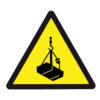Questions & Answers
Correct Answer
Look at the site and see what needs tidying or fixing
Get approval for the risk assessment from a colleague
Identify the hazards, assess the risks and implement control measures
Ensure there is access to proper personal protective equipment and the correct tools
records incidents, near-misses and accidents.
assists management in drafting a safety statement.
contains a map of the site with all hazards shown on the map.
assists management and workers in identifying hazards and control measures.
The client
The architect
The employer
The local authority
A lifting plan prepared by a competent person
Dry weather
Toolbox Talk procedures
Knowledge of the load's minimal weight
The client
The project management team
The whole construction workforce
The operatives who will be undertaking works associated to the risk assessment
They describe the risks of a task.
They ensure accountability if something goes wrong.
They teach how a construction task should be carried out.
They outline the risks of carrying out a task and the process for mitigating the likelihood of a risk happening.
A toolbox talk
A traffic management plan
A safe system of work plan
The likelihood/chance of a hazard causing harm to someone
Slips, trips and falls
Something on a site that can cause harm
An accident that has occurred on site
A toolbox talk
Decide who may be harmed
Review the risk assessment
Assess the risks and take action
Identify hazards, i.e., anything that may cause harm
Identify hazards, evaluate the risks and decide precautions
Record all hazards that have caused injury on the site in the past
Trial all risks with the site team, evaluate and record findings
Identify hazards, test them, record findings, then eliminate risks
The site engineer
The client
The health and safety manager
Everyone briefed by the risk assessment
Identifying all potential hazards that could cause harm
Listing the operatives and stating their names and occupations
Reviewing the risk assessment on a regular basis and revising it to suit the job being carried out
Evaluating the risks arising from hazards and deciding whether existing precautions are adequate
It requires all employers to protect themselves at work.
It requires all employees to provide a safe place to work.
It illustrates how employees should set out a legal risk assessment.
It puts legal obligations on employees and employers regarding their acts or omissions.
ask the presenter for clarification.
disregard it, as health and safety is the site manager’s responsibility.
carry on with their work and attend another induction the following day.
wait until the presentation is over, as it may be explained during the remaining time.
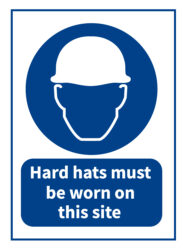
a warning action.
an advised action.
a prohibited action.
a mandatory action.
All activity on the site must cease immediately.
All personnel must leave the site.
The specified activity must cease until the inspector's issues have been addressed and rectified.
The site manager is the only person permitted to remain on site until the inspector's issues have been addressed and rectified.
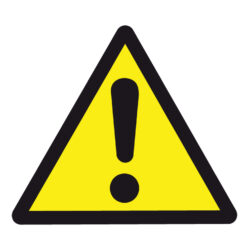
Do not enter
There is a hazard ahead
Warning of chemical substances ahead
You must immediately stop what you are doing
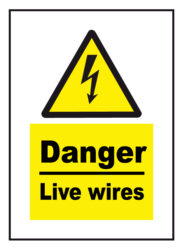
a warning.
a mandatory action.
prohibited behaviour.
firefighting information.
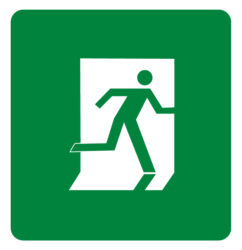
site office.
fire hydrant
falling from heights' hazards.
emergency escape and first aid kit.
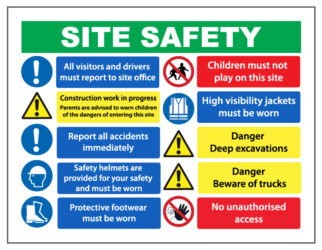
workers.
all visitors.
site managers.
vehicle drivers.
The duty holder should always appeal an improvement notice.
The duty holder should note the inspector's concerns but wait for a prohibition notice before taking action.
The duty holder should comply within the specified period to rectify the issues within the improvement notice.
The duty holder should wait until the specified period has elapsed before starting to address the detail of the notice.
Immediately
Within 5 working days
Within 7 working days
When the incident has been fully investigated
at all times.
during the actual excavation of hard material, like rock.
during bad weather as soil heaps can slump and loose boulders can fall into the excavation.
whenever people are working in positions where earth and other material can slide down or fall on them.
Which of the following conditions must be met before an employee starts work on a construction site?
They have received an in-depth induction.
They have carried out their own risk assessment which entitles them to not carry out a method statement.
They are wearing all the correct personal protective equipment and a risk assessment has been carried out.
They are wearing the correct personal protective equipment and have completed at least half of the induction.
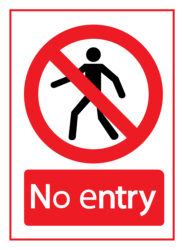
hazard sign
fire warning sign
prohibition sign.
chemical warning sign
last less than 500 days with ten people on site.
last less than 1 year with only one person on site.
last longer than 10 days with 5 people working on site
last longer than 500 person days or 30 working days (with more than 20 people working at the same time).
reduce the possibility of a heavy-duty machine rolling over.
reduce the damage to heavy-duty machinery, should it roll over.
protect nearby workers and the general public in case a heavy-duty machine rolls over.
reduce the possibility of a seat-belted operator being crushed, should a heavy-duty machine roll over.
the probability of construction machinery causing harm on a construction site
the likelihood of high winds causing damage to a scaffold
the likelihood that a person may be harmed, or suffer adverse health effects, if exposed to a hazard.
the possibility of equipment or buildings being damaged, but the time or circumstances are unknown.
A fire, explosion, electrical shortcut, etc
The controlled demolition of any building or structure
Minor injuries to the public, e.g., a short illness (less than 5 days)
Minor injuries to site operatives, e.g., a short illness (less than 5 days)
Fires
Chemical spills
Electrical failures
Slips, trips, and falls
Identify what could cause injury or illness
List the contractors and sub-contractors that are on site
Decide how likely it is that someone could be harmed and how seriously
Take action to eliminate the hazard or, if that's not possible, control the risk
Something that would not hurt anyone else
Something with the potential to cause harm to a person
Something that only happens when other trades are on site
Something that happens after it has been identified within the risk assessment
Monitor risks
Evaluate risks
Identify hazards
Decide who may be harmed
Disease
Falling from height
Slips, trips, and falls
Eating in the site canteen
Ensure the hazard is removed
Put personal protective equipment in place
Ignore the hazard.
Ensure only certain people are exposed to the hazard
With regard to health and safety regulations, which of the following is the best definition of risk?
Risk is any act that ensures all site rules are followed
Risk is any act that can cause harm or suffer health effects.
Risk is any source of potential damage than can happen when travelling to work
Risk is the likelihood that a person may be harmed or suffers adverse health effects if exposed to a hazard.
Manual handling has no risks associated with it.
Two people are aways required when carrying out manual handling.
Manual handling risks can be eliminated by eliminating the action itself.
Trolleys and other mechanical aids reduce the risk of manual handling related injuries.
To protect local wildlife
It helps the environment
It does not need to be recognised as it is not important
To make sure everyone is safe and aware of all the hazards and risks
There may be different workers and different working environments for each job.
Hazards and risks differ between sites.
Employers can be sued for copyright infringement and/or plagiarism.
To create a new filing record for each site.
The people who will be on site that day
The commercial consequences of someone being harmed by a hazard
The likelihood of how someone can be harmed by the hazards present
The emissions produced from using a preventative measure to eliminate a hazard
Appoint a banksman to supervise.
Check for the possibility and location of live services
Carry out a utility scan that is at least one mile away from the location of the excavation.
Ensure that employees will know proper safe work procedures and have adequate supervision.
To protect workers on site from harm
To protect designers from design risks
To protect the general public from harm
To protect contractors from insurance claims
It is a list of risk owners on a project.
It is the hierarchy of risk elimination and reduction.
It is a list of jobs that need to be carried out on site.
It is a list of risk assessments carried out in the last month
an action plan for evacuations.
a formal procedure for first aid on site.
a programme for assessing risks in the workplace.
an action programme for safeguarding the health and safety of those at work.
With a cover painted with reflective paint
With a cover made only of metal or wood
With a cover that is secure from displacement
With a cover that supports twice the weight of employees, equipment and material that might be imposed at any time
Is the tower stable on level ground?
The location of the work?
Has the tower been erected by a competent person?
Can the work be completed without the need to work at height?
Do not attempt any work when winds are above 15kph.
Only one person can be on a scaffold staircase at a time.
Each platform must display signs informing users of risks.
Scaffolding must be inspected and signed off by a competent person.
a body-holding device, fixed to a reliable anchor.
used on floors of working platforms to prevent slips and trips.
an automatic risk assessment prior to starting work at heights.
a method to calculate and restrain the number of workers allowed to work at height.
A valid up to date Safe Pass Registration Card
A minimum of 5 years practical site experience
Knowledge of and compliance with safety law
Adequate information, training, instruction and supervision



